
 |
||
SOVIET VOROSHILOV ACADEMY LECTURES
|
LESSON III: TACTICAL AND OPERATIONAL
CALCULATIONS
|
||
1. General: In this three hour lesson the students will become familiar
with Soviet mathematical approaches to decision making. They will consider a
series of specific problems isolated from tactical situations and focus on the
formulas, nomograms, tables, and other technical aids for calculations. The
problems will be seen again in tactical and operational settings in the later
practical exercises.
|
||
DISCUSSION AGENDAOperational and Tactical Calculations
|
||
LESSON NOTESOperational calculations
|
||
CLARIFICATION OF THE MISSION
|
||
ESTIMATE OF THE SITUATION
|
||
CALCULATIONS DURING COMBAT
|
||
LIST OF VIEWGRAPHSVG1 - Introduction and outline of Lesson III VG2 - Basic time and distance calculation VG3 - Basic time and distance calculation VG4 - Nomogram - time and distance calculation VG5 - Example basic time and distance VG6 - Calculation of time to begin move to start line VG7 - Calculation of time to begin move to start line VG8 - Nomogram - time to begin move to start line VG9 - Example - time to begin move VG10 - Calculation of time to deploy into a new assembly area VG11 - Calculation of time to deploy into a new assembly area VG12 - Nomogram - time to deploy into new area VG13 - Example - time to deploy in new area VG14 - Calculation of time unit arrives in a new area VG15 - Table Calculation of time unit arrives in a new area VG16 - Blank table Calculation of time unit arrives in a new area VG17 - Calculation of time unit arrives in a new area VG18 - Example - time unit arrives in a new area VG19 - Calculation of the duration of a march from one area to another VG20 - Table calculation of duration of march VG21 - Blank table calculation of duration of march VG22 - Calculation of the duration of march from one area to another VG23 - Example - duration of march VG24 - Determine the required movement rate for a unit to regroup in a new area VG25 - Form for calculating required travel speed VG26 - Blank form for calculating required travel speed VG27 - Determine the requried movement rate for a unit to regroup in a new area VG28 - Example - required movement rate VG29 - Calculation of length of route, average speed and duration of movement of moving column VG30 - Form for calculation of transit time over multisegment route VG31 - Blank form for calculation of transit time over multisegment route VG32 - Calculation of transit time over multisegment route VG33 - Example - transit time over multi-segment route VG34 - Calculation of overall depth of column consisting of several sub-columns VG35 - Nomogram - calculation of total length of column VG36 - Calculation of overall depth of column consisting of several sub-columns VG37 - Example - total depth of column VG38 - Calculation of duration of passage of narrow points and difficult segments VG39 - Nomogram - duration of passage of narrow point or obstacle VG40 - Calculation of duration of passage of narrow points and difficult segments VG41 - Duration of passage of narrow points and difficult segments (2) VG42 - Duration of passage of narrow points and difficult segments (3) VG43 - Duration of passage of narrow points and difficult segments (4) VG44 - Duration of passage of narrow points and difficult segments (5) VG45 - Example - duration of passage of obstacle VG46 - Example - duration of passage of obstacle (2) VG47 - Example - duration of passage of obstacle (3) VG48 - Nomogram time to surmount long obstacle VG49 - Calculation for passage times across start point (sl) by the head and tail of the column VG50 - Calculation for passage times across start point (sl) by the head and tail of the column VG51 - Nomogram - time to cross start or control point VG52 - Calculation for passage times across start point (sl) by the head and tail of the column (2) VG53 - Example time to pass point VG54 - Calculation of expected time and distance of point of contact with advancing enemy VG55 - Calculation of expected time and distance of point of contact with advancing enemy VG56 - Nomogram - calculation of time and distance to point of contact VG57 - Example - calculation time and distance of point of contact with advancing enemy VG58 - Solution - calculation time and distance of point of contact with advancing enemy VG59 - Calculation of time required for advancing and deploying sub-units to change from line of march into the attack VG60 - Calculation of time required for advancing and deploying sub-units to change from line of march into the attack VG61 - Table calculation of time to advance and deploy VG62 - Calculation of the time and distance to the line of contact VG63 - Table - calculation of expected time and distance to probable line of meeting engagement VG64 - Blank table - calculation of expected time and distance to probable line of meeting engagement VG65 - Calculation of the time and distance to the line of contact VG66 - Example - the time and distance to the line of contact VG67 - Calculation of expected time and rate of overtaking when pursuing the enemy VG68 - Calculation of expected time and rate of overtaking when pursuing the enemy VG69 - Calculation of expected time and rate of overtaking when pursuing the enemy (2) VG70 - Nomogram - expected time and rate of overtaking enemy VG71 - Example - expected time and rate of overtaking when pursuing the enemy VG72 - Example - expected time and rate of overtaking when pursuing the enemy (2) VG73 - Example - expected time and rate of overtaking when pursuing the enemy (3) VG74 - Calculation of the work time available to the commander and staff for organizing repulse of advancing enemy forces VG75 - Calculation of the work time available to the commander and staff for organizing repulse of advancing enemy forces VG76 - Nomogram - work time available to commander and staff VG77 - Example - work time available to the commander and staff for organizing repulse of advancing enemy forces VG78 - Example - work time available to the commander and staff for organizing repulse of advancing enemy forces (2) VG79 - Determination of quantity of various means for task performance VG80 - Determination of quantity of various means for task performance VG81 - Determination of quantity of various means for task performance VG82 - Determination of quantity of various means for task performance VG83 - Determination of quantity of various means for task performance VG84 - Nomogram - quantity of weapons and probibility to fulfill task VG85 - Determination of quantity of various means for task performance (2) VG86 - Example - quantity of means for task performance VG87 - Example of quantity of various means for task performance (2) VG88 - Modeling battle VG89 - Coefficients of comensurability VG90 - Modeling battle VG91 - Modeling battle VG92 - Calculation of strike capability of sub-units VG93 - Calculation of strike capability of sub-units VG94 - Example of strike capability of sub-units VG95 - Calculation of the width of main attack sector VG96 - Calculation of the width of main attack sector VG97 - Example of the width of main attack sector VG98 - Calculation of required destruction of enemy VG99 - Calculation of required destruction of enemy VG100 - Nomogram - required destruction graph VG101 - Example - of required destruction of enemy VG102 - Calculation of rate of advance in relation to correlation of forces VG103 - Nomogram - F factor and correlation of forces VG104 - Example - rate of advance in relation to correlation of forces VG105 - Nomogram - Force attrition army VG106 - Nomogram - Force attrition front VG107 - Determine the required amount of manpower and weapons for bringing sub-units back up to sufficient strength to restore their combat capability VG108 - Form for calculation of required amount of forces VG109 - Blank form for calculation of required amount of forces VG110 - Determine the required amount of manpower and weapons for bringing sub-units back up to sufficient strength to restore their combat capability VG111 - Example - the required amount of manpower and weapons for bringing sub-units back up to sufficient strength to restore their combat capability VG112 - Determine the expected radiation dose VG113 - Determine the expected radiation dose VG114 - Nomogram - determine expected radiation dose VG115 - Determine the expected radiation dose VG116 - Example - the expected radiation dose VG117 - Form for calculation of expected radiation dose VG118 - Form - Quantitative characteristics of alternative routes VG119 - Form - Effectrivenewss of artillery fire damage VG120 - Form Effectiveness of artillery fire damage II VG121 - Calculation to determine the effectiveness of fire destruction means VG122 - Form for calculating weapons effectiveness VG123 - Calculation to determine the effectivenss of fire destruction means VG124 - Example - determine the effectiveness of fire destruction means
|
||
LESSON III OPERATIONAL CALCULATIONS SAMPLE EXERCISES |
||
Operational and Tactical Calculations
|
||
Solution:
|
||
Example 2: Calculate the required speed of movement for the column to
reach the start line with a distance of 7.5 km and a time of 45 min.
|
||
3 Calculation of Time to Deploy into a New Assembly Area
|
||
Example problem: Calculate the time required for a column to occupy a
new area if the length of the column is 7 km, the depth of the new area is 3.5
km and the speed of movement during deployment is 10 kph.
|
||
Example problem: Calculate the time required for a column to occupy a
new area if the length of the column is ____km, the depth of the new area is
____ km and the speed of movement during deployment is ___ kph.
|
||
4 Calculation of Time a Unit will be in a New Area
|
||
5 Calculation of the Duration of a March from one Area to Another
|
||
6 Determine the Required Movement Rate for a Unit to Regroup in a New
Area
|
||
7 Calculation of Length of Route, Average speed and Duration of
Movement of Moving Column
|
||
8 Calculation of Overall Depth of Column
Consisting of Several Sub-columns
|
||
Example using the nomogram (Figure 89): Determine the length of a moving formation if there are 3
moving columns and the distances between them is 400 meters, the overall number
of vehicles is 65, distance between vehicles is 25 meters (variant a).
|
||
Example using the nomogram (Figure 89):
|
||
9 Calculation of Duration of Passage of Narrow Points and Difficult
Segments
|
||

The formula for major obstacles:
|
||
 |
||
Example using nomogram (Figure 90):
|
||
 Example using nomogram (Figure 91):
|
||
Example Calculation (A): Calculate the time required to cross an
obstacle by a column of ____ vehicles with distance between vehicles of ___
meters and a maximum speed of ____ kph.
|
||
10 Calculation for Passage Times Across Start Point (SL) by the Head
and Tail of the Column
|
||
 |
||
11 Calculation of Expected Time and Distance of Probable Point of
Contact with Advancing Enemy
|
||
12 Calculation of Time Required for Advancing and Deploying Sub-units
to Change From Line of March into the Attack
|
||
13 Calculation of the Time and Distance to the Line of Contact
|
||
 |
||
14 Calculation of Expected Time and Rate of Overtaking when Pursuing
the Enemy
|
||
 |
||
15 Calculation of the Work Time Available to the Commander and Staff
for Organizing Repulse of Advancing Enemy Forces
|
||
17 Determination of Quantity of Various Weapons, Reconnaissance,
Support, Communications etc. for Task Performance
|
||
19 Calculation of Strike Capability of Sub-units
|
||
20 Calculation of the Width of Main Attack Sector
|
||
21 Calculation of Required Destruction of Enemy
|
||
22 Calculation of Rate of Advance in Relation to Correlation of Forces
|
||
24 Determine the Required Amount of Manpower and Weapons for Bringing
Sub-Units back up to Sufficient Strength to Restore their Combat Capability
|
||
25 Determine the Expected Radiation Dose
|
||
29 Calculation to Determine the Effectiveness of Fire Destruction Means
|